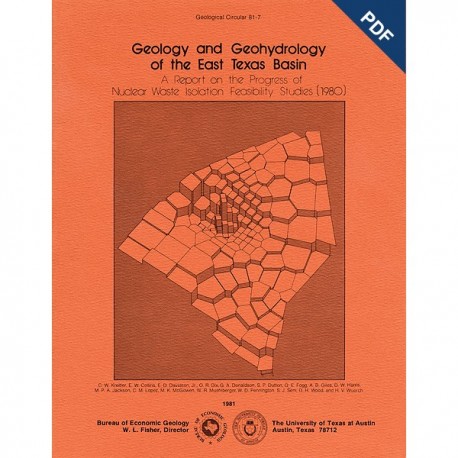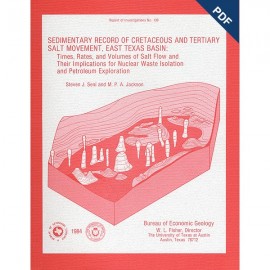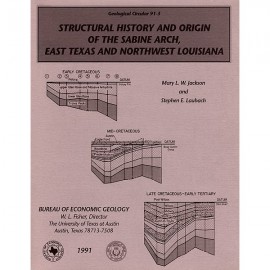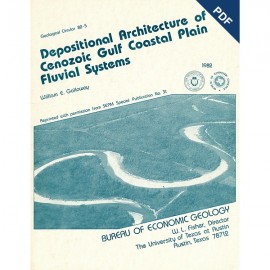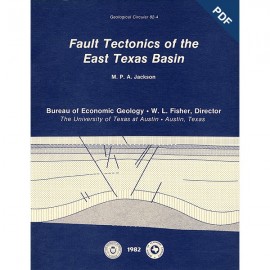Geological Circulars
-
Books & Reports
- Reports of Investigations
- Guidebooks
- Udden Series
- Geological Circulars
- Down To Earth
- Atlases of Major Oil and Gas Reservoirs
- Texas Memorial Museum Publications
- Environmental Geologic Atlas of the Texas Coastal Zone
- Mineral Resource Circulars
- Other Reports
- Seminars and Workshops
- Handbooks
- Submerged Lands of Texas
- Symposia
- Annual Reports
- Open File Reports
-
Maps & Cross Sections
- Thematic Maps
- Miscellaneous Maps, Charts & Sections
- Geologic Atlas of Texas
- STATEMAP Project Maps
- Geologic Quadrangle Maps
- Cross Sections
- Highway Geology Map
- Energy and Mineral Resource Maps
- Shoreline Change and Other Posters
- Wilcox Group, East Texas, Geological / Hydrological Folios
- Bouguer Gravity Atlas of Texas
- River Basin Regional Studies
- Featured Maps
- Posters
- Teachers & the Public
-
Geological Society Publications
- Gulf Coast Association of Geological Societies
- Alabama Geological Society
- Austin Geological Society
- Corpus Christi Geological Society
- Houston Geological Society
- Lafayette Geological Society
- Mississippi Geological Society
- New Orleans Geological Society
- South Texas Geological Society
- GCS SEPM Publications
- Historic BEG & UT Series
Geology and Geohydrology of the East Texas Basin...(1980). Digital Download
GC8107D
For a print version: GC8107.
GC8107D. Geology and Geohydrology of the East Texas Basin, A Report on the Progress of Nuclear Waste Isolation Feasibility Studies (1980), by C. W. Kreitler, E. W. Collins, E. D. Davidson, Jr., O. R. Dix, G. A. Donaldson, S. P. Dutton, G. E. Fogg, A. B. Giles, D. W. Harris, M. P. A. Jackson, C. M. Lopez, M. K. McGowen, W. R. Muehlberger, W. D. Pennington, S. J. Seni, D. H. Wood, and H. V. Wuerch. 207 p., 119 figs., 15 tables, 1981. doi.org/10.23867/gc8107D. Downloadable PDF
To purchase this publication in book format, please order GC8107.
ABSTRACT
The third year of research was highlighted by the integration of regional basinal studies with growth histories for specific domes, studies of cap-rock diagenesis and salt deformation, preliminary studies of ground-water flow and geochemistry around Oakwood Dome, and preliminary studies of microseismicity in the Mount Enterprise fault zone.
During FY 1980 we significantly advanced our understanding of the hydrologic and geologic stabilities of East Texas salt domes by analyzing extensive data acquired during FYl979. Important new data sources included (1) 194 m (636 ft) of core from the calcite and anhydrite cap rock and salt section of Oakwood Dome; (2) microseismic data from a seismometer on the Mount Enterprise fault system; and (3) five hydrologic monitoring wells completed around Oakwood Dome.
The integration of formation-specific studies (that is, Cotton Valley-Hosston, Paluxy, Nacatoch, and Wilcox Formations) has permitted reconstruction of a threephase history of the tectonic and sedimentary evolution of the basin. In the initial phase, during Late Jurassic to Early Cretaceous, the basin was dominated by fault-controlled subsidence. The middle phase, during Late Cretaceous, was marked by a rapid decline in rates of subsidence and sedimentation. During the final phase, sedimentation and subsidence effectively ceased when Tertiary and Quaternary depocenters shifted to the Gulf of Mexico. Mobilization of salt and growth of domes was most active during Late Jurassic and Early Cretaceous (initial phase), and activity subsequently declined during Late Cretaceous and Tertiary. Differential rates of sedimentation within rim synclines surrounding the domes were coincident with exponential decline in sedimentation rates and basinal subsidence rates.
This general model of dome growth in the East Texas Basin is similar to the growth history of the Oakwood Dome. Maximum growth rates for Oakwood Dome occurred in Late Jurassic to Early Cretaceous and thereafter declined exponentially.
Oakwood cap rock consists of an upper calcite zone and a lower anhydrite zone. Analysis of the cap rock from Oakwood core indicates that the anhydrite zone is the result of dissolution of salt and accumulation of insoluble anhydrite residuum. This accumulation process occurred in an environment originally high in temperature and salinity, resulting in metamorphic texture to the anhydrite rock. The cap rock appears to be an effective impermeable seal that will prevent further dissolution. Lithologic analysis of salt core indicates two distinct periods of recrystallization, Deformation and recrystallization during diapir growth produced a penetrative schistosity defined by inequant halite grains, Subsequent recrystallization of the upper 2 m (6 ft) of salt in the presence of ground water under conditions of low differential stress produced a low-strain, granoblastic texture. The low-strain, recrystallized zone implies tectonic stability.
Carbon-14 dating of bicarbonate from ground waters around Oakwood Dome shows that (1) ground water increases in age downdip from the Wilcox outcrop, (2) younger ground water occurs in the uplifted Carrizo Formation surrounding Oakwood Dome, confirming that recharge is occurring over the dome, and (3) the sodium and bicarbonate concentrations are linearly related to age of the water.
Analysis of Quaternary deposits reveals no evidence of salt dome growth during Pleistocene or Recent time. Interpretation of microseismic records suggests the occurrence of small seismic events along the Mount Enterprise fault zone.
Keywords: Oakwood Dome, salt domes, East Texas, East Texas Basin, Early Cretaceous, ground water, recharge, seismic data, hydrology, waste isolation, Mount Enterprise fault system, Texas
Citation
Kreitler, C. W., and others, 1981, Geology and Geohydrology of the East Texas Basin, A Report on the Progress of Nuclear Waste Isolation Feasibility Studies (1980): The University of Texas at Austin, Bureau of Economic Geology, Geological Circular 81-7, 207 p. doi.org/10.23867/gc8107D.
